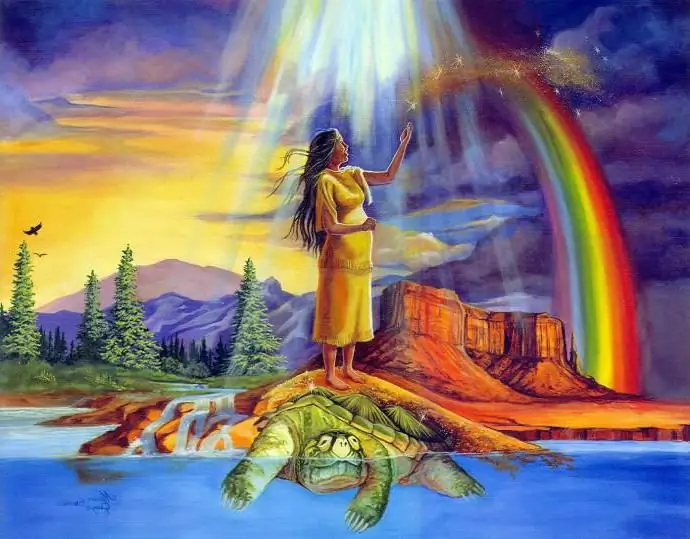- Author Henry Conors [email protected].
- Public 2024-02-12 02:46.
- Last modified 2025-01-23 09:07.
Cosmogonic myths - a category of myths that tell about the transformation of chaos into space. The word "cosmogony" is derived from two Greek words: world (or cosmos) and arise. Chaos (emptiness; from the Greek root “chao”, to yawn) in myths means primary potentiality, formless matter, from which the world will be created. The personification of the infinite and empty world space, which has no dimensions. In ancient Greek myths, the embodiment of Chaos is the Ocean or the original waters.

Cosmogonic myths are widespread in the cultures of many peoples, and the image of the Ocean in the cosmogony of ancient Greece, most likely, was formed under the influence of the ancient Sumerian culture. The act of creation represents the creation of order out of disorder. As long as order is preserved, there is peace. But it may happen that at some point there is a threat of its destruction, then it can return to a state of chaos. Almost everywhere in myths, the battle of a deity or cultural hero with a monster (sea serpent or dragon), personifying the forces of chaos, is described.
Cosmogonic myths of the AncientGreeks are well known for the poem "Theogony" by Hesiod. Chaos, according to Theogony, is the original deity who gave birth to Erebus and Nyukta (Darkness and Night). Other cosmic principles generated from it: Gaia (Earth), Tartarus (the underworld) and Eros (Love or the power of attraction). In Hesiod, Chaos is located below the Earth, but above Tartarus, the first mention of which can be found in Homer. Modern science has established that the formation of ancient Greek myths was significantly influenced by the religious systems of the Eastern Ancient World (Sumerian, Babylonian, Hittite). Of course, the cosmogonic myths presented by Hesiod in ancient Greece were not the only ones. Many philosophers developed their theories. So, among the lower strata of the population, the Orphic cosmogony, in which there is a world egg, was more popular. According to Epimenides, Air and Night first existed, from which Tartarus and a pair of gods arose, who gave birth to the world egg. The central roles of the Orphics are assigned to Dionysus and Demeter. Their fate is tied to the beginning of human history.

In the Roman tradition, in particular Ovid, cosmogonic myths describe a primordial gross and undeveloped mass into which all the elements of the cosmos were immersed in a formless heap.
In a complete survey of Greek myths and legends, known as the "Mythological Library", by an unknown writer, who is called Pseudo-Apollodorus, it is said that Gaia (Earth) and her born Uranus (Sky) ruled the first world. The sky covered the Earth (a symbol of the union of Man and Woman), and there appearedtwelve gods of the first generation (six brothers and six sisters).

In the philosophical concept of Prima Matter (the first matter), developed approximately in the 5th-6th centuries, biblical concepts and various cosmogonic myths were combined. Examples of its application can be found in the alchemists of the Renaissance, who compared the "first matter" with literally everything: Chaos, Man and Woman, androgynous being, Heaven and Earth, Body and Spirit. They used similar comparisons to describe the universal nature of Prima Matter, which has the qualities and properties of all things.






